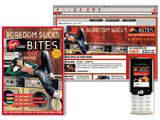Keeping well connected
As mobile telecoms get more sophisticated, handsets must become more intuitive.

‘I wake up every morning thinking of my mum.’ So says Clive Grinyer, director of product experience at Orange, and with good reason.
For if his mother would struggle with any task on one of Orange’s mobile phones, then it’s not user-friendly enough in Grinyer’s book.
Usability is the buzz word in the mobile telecoms world. As phones become ever flashier and more technically able, they must also become more intuitive to use, because nothing damages a brand more than a bad user experience.
The last thing any network operator wants is frustrated customers staring in front of their on-screen logo, says Nicolas Roope, creative director of Poke, which works for Nokia and Orange.
A new design discipline has evolved from the joint needs of usability and brand presence, alongside the increasing technological capabilities of phones.
‘Phone space is one of the most interesting design areas currently,’ says Grinyer. He describes it as a micro version of Web design, creating graphic experiences through a much smaller window.
‘Phones now have high quality colour screens, so they are potentially as much about visual communication as audio,’ says Grinyer.
The network operators recognise this visual way to communicate is another, potentially lucrative, way to earn money. Typically, they set themselves targets of 25 per cent of revenues to come from data rather than voice. Long gone are the days of dry old text messaging, which had little call for creative input. And with 3G, which allows even more visual imagery and interaction, ‘users can have an almost televisual experience’, says Grinyer. Hence the need for clever design.
Some of the design consultancies working in this field started life in the Web arena. Major players include Digit, Start Creative, Oyster, Poke and Icon Mobile in Berlin, which was created out of MetaDesign. Some of the other ‘dotcom’ consultancies have either been slower to move into this new space, or no longer exist.
This is still a small world – there is, after all, only a handful of network operators in the UK – but the potential is significant. As the opportunity arises to pump branded content down the phone, so the operators are becoming design buyers, with offers such as Vodafone Live.
The consultancies themselves expect to benefit from this, with mobile interface design becoming a growing part of their business. It currently accounts for around 10 per cent of Poke’s business, says Roope, ‘and that will grow’.
For Icon Mobile, interface design accounts for 80 per cent of its business. As well as Orange, the German consultancy works for Telefonica in Spain, Vodafone, Sunrise in Switzerland and O2.
With their on-line backgrounds, this type of group is familiar with the issues of branding businesses on-screen and of making the user experience as workable as possible.
‘Branding and usability go hand in hand,’ says Start creative director Darren Whittingham. ‘It’s about simplifying and demystifying.’
Mobile work is about a sixth of Start’s business. ‘This will grow slightly, but it won’t explode, as we are in the middle of a huge development programme,’ he adds.
As Virgin Mobile’s brand consultancy, Start must also create an on-screen experience which is on message for the client’s core audience of urban youth. ‘A phone is a lifestyle fashion accessory. The point of difference comes back to the brand,’ Whittingham says.
Virgin Mobile has just launched an integrated entertainment service, for which Start devised the content structure and navigation, carrying through all aspects of the brand positioning.
Meanwhile, Orange has just launched a third version of its SPV (sound, picture, video) phone, customising its own icons. Interface design for this model was by Icon Mobile. As Thomas Fellger, managing director of Icon Mobile, says, ‘Branding a mobile device is different from on-line and off-line branding. It’s more about good usability.’
Others in interface design, such as Roope, stress design’s contribution to usability over branding. It’s important to work out how much complexity the user can tolerate, he says. This is not just about reducing the number of ‘clicks’ it takes to achieve a specific task, as it was with websites, but about making the route as intuitive as possible. And at this point, branding can take a back seat, says Grinyer. ‘We try to make things personal so that Orange doesn’t get in the way.’
And this will become even more pertinent as phones become increasingly complex. Orange believes that 80 per cent of its customers only use 10 per cent of their phone’s functionality, either because they don’t need it or because they can’t find it.
This means that these opportunities have brought with them a lot of problems. Students at the Interaction Design Institute at Ivrea in northern Italy, founded by Telecom Italia and Olivetti, are finding they are increasingly focusing their thoughts on mobile telecoms.
At a recent workshop with Telecom Italia Research Lab, students explored contexts for video communication and video communication services, and how they could enhance people’s interactions with each other. For Ivrea’s academic director Gillian Crampton Smith it is important to design an experience and not just a device.
Because of the tendency to load devices with multiple functions and activities, sometimes even provided by different agents and providers, Crampton Smith argues for a service design approach that looks beyond the device and incorporates user motivations, the service ecology and service touch points. The issues of service design are also being tackled by a new breed of consultancies in the UK, such as FHIOS and Livework.
As the boundaries between phones and computers continue to blur, those lucky consultancies with a foot in the door are best placed to be at the front of the design queue.
-
Post a comment



